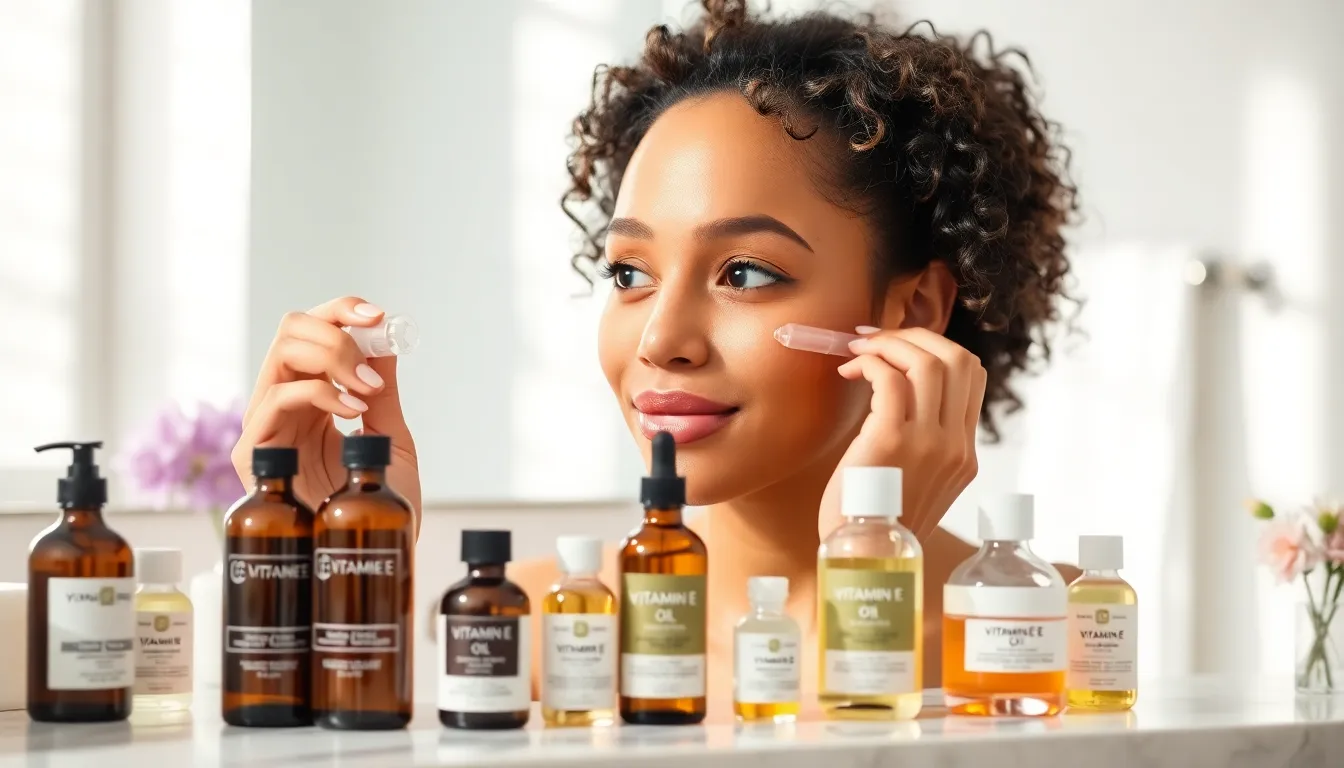Vitamin E isn’t just a letter in the alphabet; it’s a skincare superhero that’s ready to rescue your complexion. If you’re tired of dull, dry skin that feels like a desert, layering vitamin E might just be your new best friend. This powerhouse antioxidant can transform your skincare routine from blah to brilliant, giving your skin the hydration and glow it craves.
Table of Contents
ToggleUnderstanding Vitamin E
Vitamin E serves as a key component in skincare routines. This fat-soluble vitamin is known for its powerful antioxidant properties, which can enhance skin health.
What Is Vitamin E?
Vitamin E comprises a group of compounds, including tocopherols and tocotrienols. These compounds contribute to various biological functions. Sources rich in vitamin E include nuts, seeds, and green leafy vegetables. Many skincare products also contain vitamin E for its nourishing effects. This vitamin plays a vital role in protecting skin cells from oxidative stress.
Benefits of Vitamin E for Skin
Vitamin E promotes skin hydration and elasticity. It helps reduce the appearance of fine lines and wrinkles. By neutralizing free radicals, vitamin E encourages youthful skin. It also aids in healing scars and minimizing discoloration. Incorporating vitamin E into a daily skincare routine leads to a healthier complexion.
Layering Vitamin E in Your Skincare Routine

Layering vitamin E effectively enhances its benefits. Achieving vibrant skin requires a systematic approach to incorporating vitamin E into everyday skincare.
Ideal Products for Layering
Look for serums, oils, and creams specifically formulated with vitamin E for optimal results. Prioritize products containing tocopherols and tocotrienols, as these compounds deliver powerful benefits. Consider products that combine vitamin E with other beneficial ingredients, such as hyaluronic acid or peptide compounds. Ensure the formulation complements your skin type; lightweight formulations suit oily skin while richer creams benefit dry skin. Popular brands that offer vitamin E-infused products include The Ordinary, Paula’s Choice, and Kiehl’s.
How to Properly Layer Vitamin E
Start with a clean face to maximize absorption of vitamin E products. Apply water-based serums first, followed by vitamin E oils or creams to lock in moisture. Gently massage these products into the skin, focusing on areas needing extra hydration. Apply sunscreen last in the morning routine for protection against UV rays. Repeat the process at night for continuous nourishment. Adjust the frequency based on skin responsiveness, ensuring it remains balanced and hydrated.
Potential Benefits of Layering Vitamin E
Layering vitamin E offers significant advantages for skin health. It can transform the texture and overall appearance of skin.
Enhancing Moisture Retention
Vitamin E plays a key role in moisture retention. It creates a barrier that prevents water loss from the skin, keeping it hydrated. Products rich in vitamin E help shield the skin from environmental stressors. Individuals often experience improved skin elasticity and softness with its regular application. When combined with other moisturizing agents, vitamin E enhances their effectiveness, providing deeper hydration. This dynamic duo maximizes the benefits, ensuring a plump and supple complexion.
Boosting Antioxidant Protection
Antioxidant protection is another potential benefit of layering vitamin E. This vitamin neutralizes free radicals that can damage skin cells, preventing premature aging. By applying vitamin E, individuals can enhance their skin’s natural defenses against UV rays and pollution. When layered with other antioxidants, such as vitamin C, the protective effects multiply, leading to a more resilient skin barrier. Therefore, vitamin E becomes an essential ally in the fight against oxidative stress, promoting a healthier and more vibrant complexion.
Precautions When Layering Vitamin E
Caution is essential when layering vitamin E in skincare routines. Understanding how it interacts with skin types ensures optimal benefits.
Possible Skin Reactions
Allergic reactions can occur. Individuals may experience redness, itching, or breakouts after using vitamin E. Sensitivity varies among skin types, so it’s vital to perform a patch test before full application. Notably, those with oily skin may find it causes excess greasiness or clogging of pores. If irritation arises, discontinuing use immediately is crucial. Consulting a dermatologist also helps in identifying sensitivities or alternatives.
Choosing the Right Concentration
Selecting the appropriate concentration of vitamin E is vital for effectiveness. Formulations generally contain 0.5% to 5% vitamin E. Higher concentrations can enhance benefits but increase the risk of irritation. Individuals with sensitive skin should start with lower concentrations. Examining product labels for tocopherols helps in identifying quality. Opting for formulations tailored to specific skin concerns ensures better compatibility and results. Adjusting usage frequency allows gradual skin adaptation to vitamin E’s effects.
Layering vitamin E in a skincare routine can significantly enhance its benefits. By carefully selecting products and following proper application techniques, individuals can achieve a well-hydrated and radiant complexion. The antioxidant properties of vitamin E not only protect the skin but also work synergistically with other beneficial ingredients.
However it’s essential to approach layering with caution. Performing patch tests and choosing the right concentration can help avoid potential skin reactions. With the right strategy, vitamin E can be a game changer in achieving healthier and more youthful skin. Embracing this powerful ingredient can lead to lasting improvements in skin texture and overall appearance.





